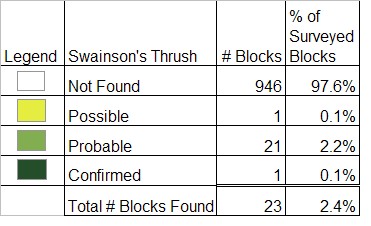Breeding Bird Atlases (BBA)
Find a Bird - BBA1
Breeding Bird Atlas 1 Species Accounts
Swainson's Thrush
Catharus ustulatus
Egg Dates
early June to mid-July
Number of Broods
one

The Swainson’s Thrush is a bird of the Canadian Zone, including the scattered upland coniferous woods that dot the western limits of our state. There, it is a fairly common summer resident, its calls being among the most characteristic sounds of the habitat. Its distribution since historical times remains basically unchanged. Since the Atlas period, nesting birds have been discovered in western Hampshire County, but there have been no recent summer records from northern Worcester County.
In spring, the Swainson’s Thrush is among the later migrants to make an appearance in the Northeast. Seldom does it arrive before the second week of May, with peak numbers of transients occurring later in the month. In this season, the species is often seen with its migrant companions, the wood-warblers, feeding in the branches of the blossoming spring woodland as well as on the ground. Migration in the spring occurs on a broad front, evidence of which is to be heard on quiet evenings when the notes of the Swainson’s Thrush may be easily distinguished overhead. Listening for the diagnostic flight call of this species, observers have recorded hundreds or even thousands in a single evening.
The five eastern North American forest thrushes are renowned for their beautiful songs. Compared with the Hermit Thrush, with which it often shares breeding habitat, the Swainson’s Thrush is not nearly the virtuoso songster. Yet, though its song may lack the celebrated ethereal quality of the Hermit Thrush’s, its musical strain remains one of our woodlands’ finest. The Swainson’s Thrush sings quite commonly during spring migration but is more vocal on its breeding grounds, where its song spirals upward from the dense, evergreen woods. The common call note is a short whit, and the flight call is a sharp queep.
In Massachusetts, Swainson’s Thrushes commonly choose an area of dense, young spruce woods for a breeding site. There, often near a stream or boggy area, a territory is established. At lower elevations, such as the Huntington-Chester area, the breeding territories center on stands of Eastern Hemlock surrounded by primarily deciduous forest, including such species as Yellow Birch, Black Cherry, and American Beech (Blodget, Meservey). Nests are invariably placed upon horizontal branches, usually 3 to 6 feet, rarely up to 20 feet, from the ground and are so well made as to have commanded the praises of many early naturalists. The nest has been described as more elaborately and neatly constructed than that of any of our other thrushes. Conspicuous among the materials are the Hypnum mosses, which by their dark fibrous masses give a very distinctive character to these nests and distinguish them from all others. Besides these materials, other nest elements are fine sedges, leaves, stems of horsetail, red glossy vegetable fibers, the flowering stems of the reindeer lichen and other lichens, and fine strips of bark.
The Swainson’s Thrush usually lays three to four eggs, which are incubated by the female. Specific data on Massachusetts nests is lacking, but observations of the behavior of adults indicate that the range of egg dates extends from early June to mid-July (Hendricks). In 11 to 14 days, the young hatch, and, in 10 to 12 more days, they have outgrown the confines of the nest. The adults are especially busy during this time of peak food demand, trying to satisfy the appetites of their family. Food includes a variety of insects, captured on the ground or in flight. The moth adults of the infestant Spruce Budworm may be taken. A good percentage of wild fruits, such as soft-skinned blackberries and raspberries, are eaten, especially in midsummer.
By late summer, both adults and juveniles have completed their molts, and in mid-September the Swainson’s Thrush is once again on migration. In the fall, the birds tend to be quieter and much less arboreal. This may account for the relatively small number of fall migrants observed. However, as in the spring, high counts of migrants may be made in the evening, if weather conditions are suitable. Swainson’s Thrushes continue their southward movement through Massachusetts until about mid-October. Very rarely, individuals remain much later, occasion ally into December. The species winters in Latin America, from southern Mexico to Argentina.
Map Legend and Data Summary
Atlas 1 data collected from 1975-1979


Brian E. Cassie



